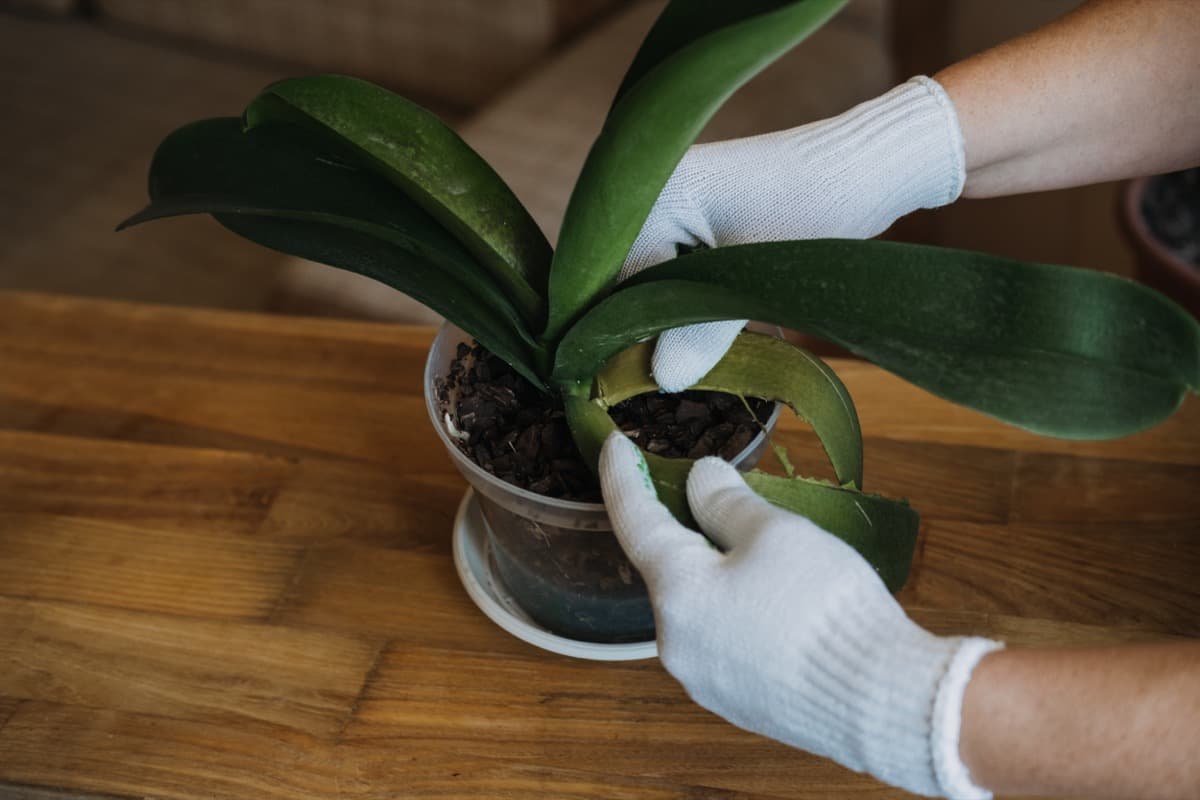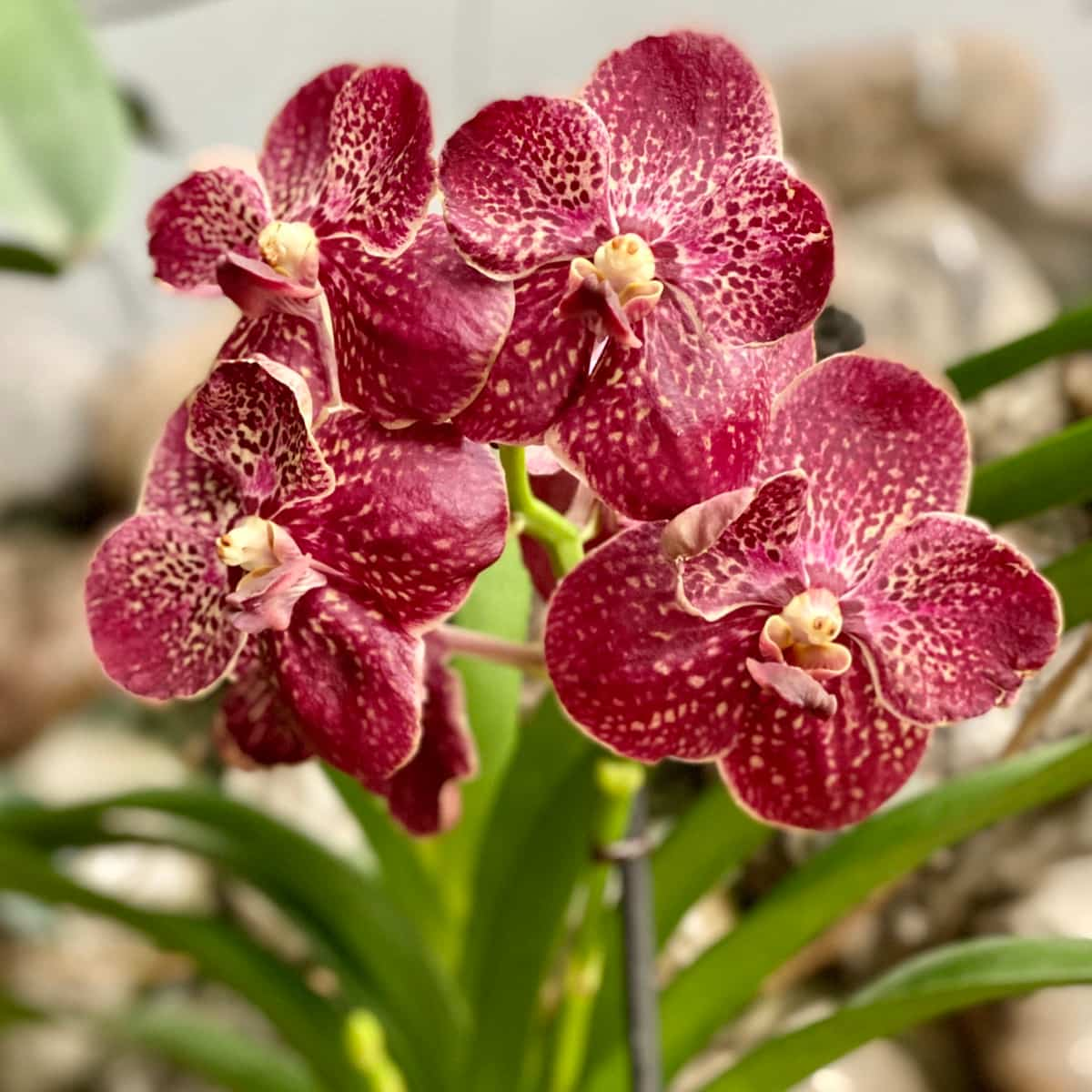The maintenance requirements of orchids are notoriously high to ensure optimal growth. In a happy environment, they can do great things, including lots of growth and a stunning display of flowers. Nonetheless, if you compromise an orchid’s environment in the following ways, it will drop its leaves. Several common factors cause a plant’s leaf drop; not all are doomsday signs.

10 Reasons Why Your Orchid is Dropping Leaves
Overwatering as a Reason for Orchid Leaf Drop: Symptoms and Solutions
Undoubtedly, orchids love a lot of water, but they must dry out a bit between waterings. The roots of your plant will rot if they are perpetually wet. If the roots of the orchid are rotted, they will be soft, mushy, and brown or black. Drive your finger into the potting mix and observe moisture. Only if it is dry its time to water your plant.
Alternatively, if you haven’t repotted your orchid in a long time and the potting mix has broken down, your potting medium may have remained wet for too long. Cut off rotten and dead roots from your plant after you remove it from its pot. Repot your plant into a fresh growing medium after discarding all potting mixes.
Insufficient Light and Orchid Leaf Drop: Understanding the Connection
Orchids may drop leaves if they are exposed to insufficient light. As a result, the plant cannot photosynthesize properly, resulting in a lack of energy for growth and maintenance. Insufficient light can also stress plants, which increases their susceptibility to disease and pests. Consider taking your orchid to an east-facing window and keeping it there for a few hours.
After that, return it to its previous location and repeat the process the next day. Grow lights can be used instead of bright windows if you cannot access any. Remember to keep your plants at least a foot away from artificial lighting since it can also burn them. The orchid needs at least 6-8 hours of light per day, so make sure it’s available in whatever manner you see fit!
Temperature Fluctuations and Orchid Leaf Drop: How to Maintain Stability
Fluctuations in temperature can be detrimental to the health of orchids, resulting in leaf drop and other issues. Various steps need to be taken to maintain stability and ensure the health of orchids.
- Orchids should be kept away from drafty areas, such as areas near doors and windows.
- Block direct sunlight with blinds or curtains to avoid temperature fluctuations caused by direct sunlight.
- You should place your orchids in a room with a controlled temperature, such as a heated or cooled room.
- Monitor the temperature around your orchids and adjust it using a thermometer.
- Maintaining consistent humidity levels with a humidifier since dry air can cause temperature fluctuations.
Nutrient Deficiencies and Orchid Leaf Drop: Identifying and Correcting Imbalances
Nutrient deficiency is the ultimate cause of leaf fall from root rot. There are other reasons why this can happen, and the result is the same. As the leaves near the plant turn yellow and soft, they eventually fall off. There is nothing better for orchids than fertilizer. Since they don’t receive many nutrients from their potting medium, they must be fertilized regularly to avoid being sad and unhealthy. Fertilizing orchids every 1-2 weeks during the growing and flowering seasons is a good practice. Dormant plants should be fertilized every three to four weeks.
In case you missed it: How to Grow and Care for Orchid Plants Indoors: A Step-By-Step Comprehensive Guide

Pest Infestation and Orchid Leaf Drop: Signs, Prevention, and Treatment
The yellowing of lower leaves is often a sign of insect infestation, especially mealybugs or scale insects. Observe small brown “shields” on leaves and stalks, scale insects, and white cottony growths, especially in leaf axils, which are mealybugs. They both secrete honeydew, a clear sticky liquid on the underside of leaves. Insecticidal soap or rubbing alcohol can be used to control both insects. In addition, isolate the infected plant from other plants.
Root Rot and Orchid Leaf Drop: Causes, Prevention, and Recovery
Interestingly, root rot has the same symptoms as lack of water: limp and droopy leaves. A cache pot overwatered, blocked by ice cubes, or filled with degraded growing mix may cause this. Aside from limp, yellow leaves, you’ll also see brown roots that are dried up or rotting rather than thick, silvery gray, with a green tip like healthy phalaenopsis roots.
A rotten potato smell indicates some roots are rotting in the growing mix. In this case, if the plant still has several healthy roots, you may be able to save it. Repot the plant in a fresh orchid growing mix after removing the rotten and dead roots.
Improper Potting Media and Orchid Leaf Drop: Selecting the Right Substrate
Potting soil or other soils not designed for orchids is a common mistake orchid growers make. In time, these soils can become compacted, causing poor drainage and an absence of aeration. It can suffocate the roots and cause the leaves to drop. Sphagnum moss, for example, is too dense, which is another mistake.
Despite its ability to hold moisture, sphagnum moss does not provide enough aeration for the roots. Rotting roots and dropping leaves can result from this. The best substrate for orchids consists of materials that drain, aerate, and retain moisture. Among the materials used are bark, perlite, and charcoal. As well as providing a good flow of air around the roots, these materials provide a good source of moisture and nutrients.
Environmental Stressors and Orchid Leaf Drop: Mitigating Their Impact
When orchid leaves droop, it indicates that sudden changes in their environment stress them. Ensure that the orchid’s environment is not too hot or humid and that there isn’t too much or too little sunlight. If possible, orchids should be placed in a sheltered spot with bright indirect light and away from drafts and sources of heat. Watering and fertilizing your orchid properly and maintaining a consistent environment in your indoor garden will prevent its leaves from drooping and encourage it to bloom again.
Orchid Leaf Drop Due to Fungal Diseases: Prevention and Management
Bacterial Soft Rot: In the beginning, the leaves will turn yellow, black, and rotten before falling off. It is imperative to act as quickly as possible if this disease strikes. All affected tissue should be removed and treated with a bactericide. There is a great deal of success with copper compounds. The use of hydrogen peroxide and bleach as a home remedy is valid.
Collar Rot: Collar Rot, also called Southern Blight, is another fungal infection that affects the roots, pseudobulbs, and leaf base. The bases of the leaves will turn a pale yellow before falling off. This should be treated with fungicide. Move your orchid to a location that benefits from improved air circulation and temperatures between 18-26 °C. Apply a broad-spectrum fungicide or bactericide according to the manufacturer’s recommendations.
Transplant Shock and Orchid Leaf Drop: Minimizing Stress During Repotting
- First, choose the right potting mix. Orchids need a specific type of mix that allows for good drainage and aeration. Look for a mix that includes bark, sphagnum moss, and perlite.
- Next, make sure you have the right pot size. Orchids prefer to be slightly root-bound, so choose a pot larger than the current one. This will help prevent overwatering and reduce the risk of transplant shock.
- Before repotting, inspect the plant for any signs of disease or pests. It’s best to treat these issues before repotting to minimize stress on the plant.
- When repotting, be gentle with the roots. Remove any dead or rotting roots, but avoid damaging healthy roots. Use clean and sharp tools to prevent the spread of disease.
- After repotting, water the plant thoroughly. This will help settle the potting mix and reduce the risk of root damage. Avoid fertilizing for at least two weeks after repotting to allow the plant time to adjust.
In case you missed it: 7 Causes of Dying Orchids and How to Fix Them?

Conclusion
In conclusion, there are several reasons why orchids may drop their leaves, including overwatering, underwatering, temperature changes, low humidity, and pest infestations. By following the appropriate treatment and control solutions, orchid owners can help their plants thrive and prevent leaf drops.
- Feed Your Flock for Less: Top 10 Tips to Save on Chicken Feed
- Ultimate Guide to Ossabaw Island Hog: Breeding, Raising, Diet, and Care
- Hatching Answers: The Top 10 Reasons Your Chickens Aren’t Laying Eggs
- Eggs and Economics: Breaking Down the Cost of Raising Backyard Chickens
- Defend Your Greens: Proven Methods to Keep Iguanas Out of Your Garden
- Ultimate Guide to Cinnamon Queen Chicken: A Comprehensive Guide for Beginners
- Ultimate Guide to California Tan Chicken: Breeding, Raising, Diet, Egg-Production and Care
- Ultimate Guide to Marsh Daisy Chicken: Breeding, Raising, Diet, and Care
- 10 Types of Chicken Farming Businesses You Can Start for Profits
=